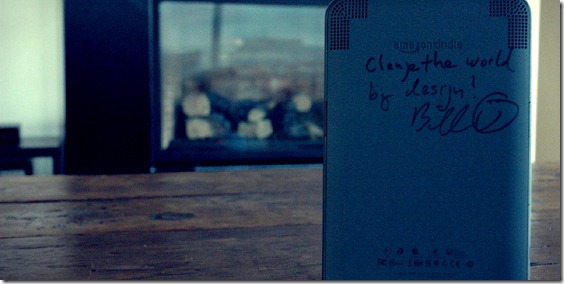Leon Battista Alberti was a fifteenth century philosopher, mathematician and altogether man of information who was the inspiration for the ‘renaissance man’ – someone who excels in multiple areas. If ever there was a modern-day interpretation of Alberti, I daresay it would be Bill Buxton.
For anyone familiar with Microsoft’s Chief Researcher, it’s difficult not to be impressed with his list of accomplishments and the breadth of his interests. (For more on Bill, check out a couple of recent profiles in the Seattle Times and Technology Review. NOTE: There’s no charge, but you’ll need to register to read the entire TR piece.)
Of course Bill’s focus on design and technology are what’s most relevant for our purposes here, but you can’t just compartmentalize those from the rest of his life. Frankly, I think those other areas – interests in film, music, backcountry skiing and birch bark canoes (to name a few) – coupled with Bill’s holistic approach to life, are part of the secret sauce that make his insights such an asset. I had dinner with him a few months back and it was a tour de force on many of these topics – and he was kind enough to sign my Kindle which houses his latest book.
Bill was formally educated as a musician and approached technology more from the aspect of an end user, rather than a technologist. From that vantage point, he found himself focused on developing computer interfaces that were less cumbersome and would make it easier to harness the technology.
It’s not about how much memory a device has, or whether that device is a laptop, a netbook, a tablet, or a pad and paper. Bill would probably be the first to say that how a person feels while they’re using the product is equally important to whether the product does what it was designed to do. Simply put, the sum of the parts is less important than the entire package.
Through the years, Bill has applied this philosophy to his research at the University of Toronto and a handful of other companies, including Xerox’s Palo Alto Research Center and AutoDesk.
He’s also created or contributed to a number of products, from the Structured Sound Synthesizer and electronic drum of the 70’s and 80’s, to the Arc Touch Mouse and Kinect, both of which Microsoft released just last year. This certainly helps explain Bill’s penchant for devices and his extensive collection of consumer and computing devices, a few of which have been on display this week in Vancouver at CHI 2011. You can check it out online at the Buxton Collection in a splendid Pivot view – or check out the video tour Bill did with Larry Larsen this week.
Among the artifacts owned by Bill are the Microwriter, the first portable digital word processor; the Casio IF-800, possibly the first example of a mobile device with a touch screen; and the Xerox PARCtab – a location-based information appliance that Bill had a hand in designing for Xerox’s ubiquitous computing work.
Despite the advances of intervening years, some of the products in Buxton’s collection show a deft approach to design. It goes to show you that for all the lack or excess of technology, the success of any product relies on ‘slipping on’ a user’s shoes and keeping them on throughout the design process.
The collection has gotten a ton of great coverage – not least a piece in The Atlantic titled The Crazy Old Gadgets That Presaged the iPod, iPhone and a Whole Lot More with a great slideshow of a subset of the devices.






